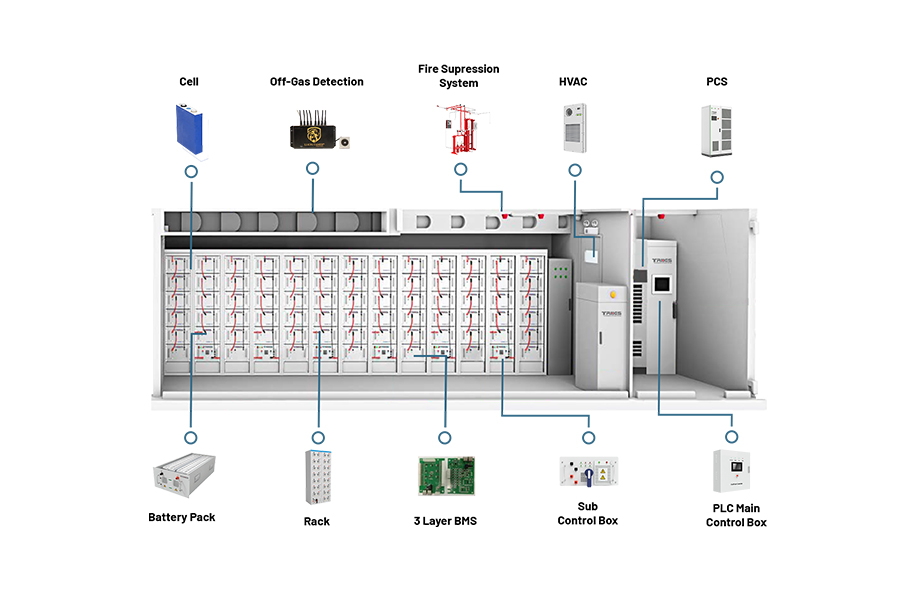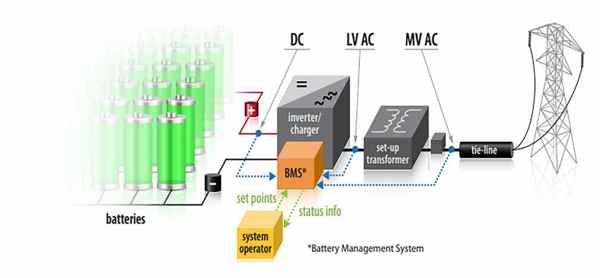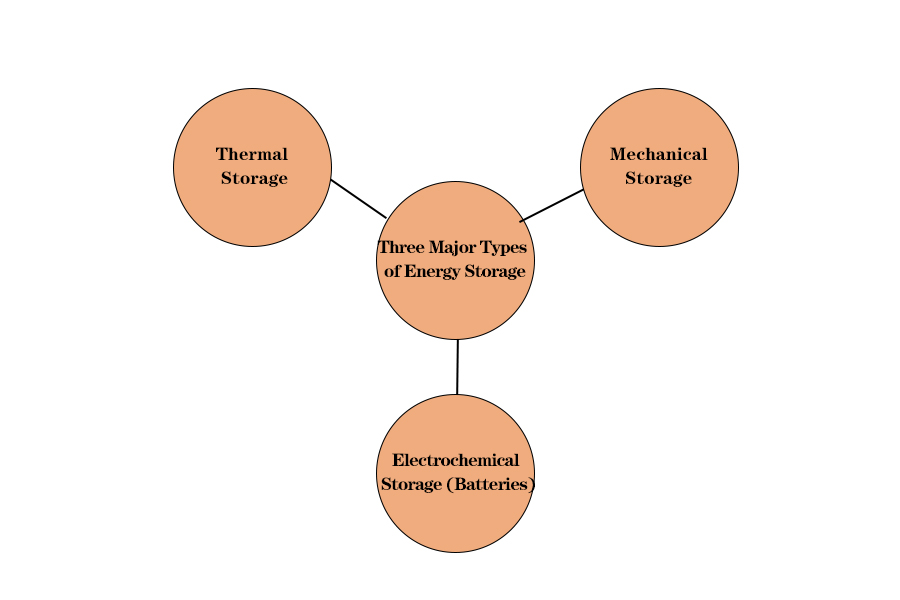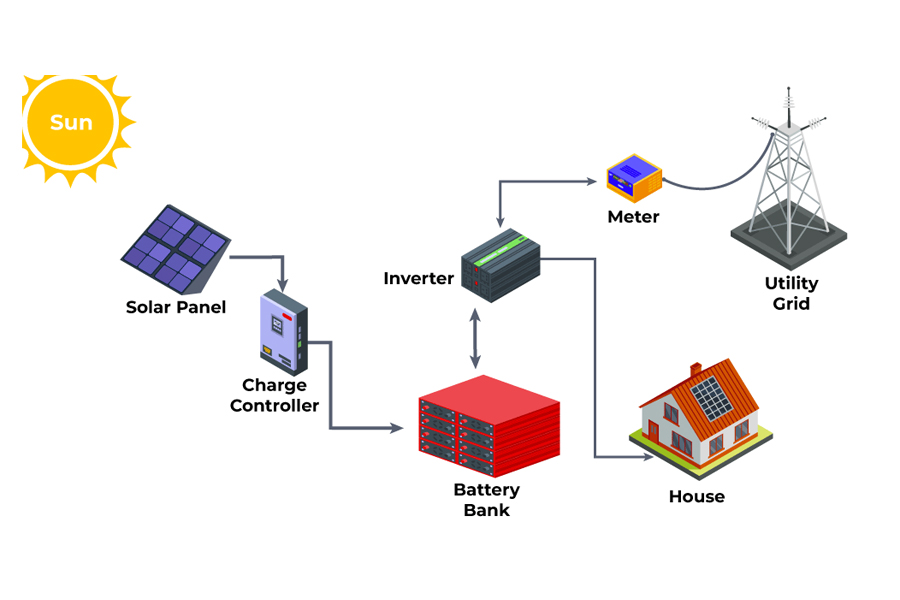Quelle est la différence entre une batterie et un bess?
Explorez-vous les options de stockage d'énergie et vous trouvez-vous un peu emmêlé dans la terminologie? Vous pourriez entendre "Batterie" et "Bess" utilisé, parfois interchangeable, Mais sont-ils vraiment la même chose? Comprendre cette distinction est fondamental pour faire des choix éclairés sur votre avenir énergétique, que ce soit pour votre maison, entreprise, ou projets plus grands.
La façon la plus simple de le dire est qu'une "batterie" (ou plus précisément, cellules et modules de batterie) est le composant central qui stocke chimiquement l'énergie électrique. Pensez-y comme le réservoir de carburant. Un bess (Système de stockage d'énergie par batterie), d'autre part, est le tout, Solution entièrement intégrée qui inclut non seulement les batteries mais aussi un système de gestion de batterie sophistiqué (GTC), un système de conversion de puissance (PCS) comme un onduleur, Logiciel de contrôle crucial, et tous les composants de sécurité et auxiliaires nécessaires. Le bess est le complet, moteur opérationnel "" Prêt à se connecter et à livrer l'énergie.

À Gycx Solaire, Nous concevons et installons des solutions BESS complètes. Alors que les batteries elles-mêmes sont vitales, C'est l'intégration intelligente de tous les composants du système qui déverrouille la véritable indépendance énergétique, efficacité, et la sécurité pour nos clients.
Approfondissons ce qu'est vraiment un Bess et répondons à certaines questions courantes.
Qu'est-ce qu'un système de stockage d'énergie BESS?
Vous avez entendu l'acronyme Bess, Mais qu'est-ce que ça englobe vraiment? Ce qui en fait plus qu'une grosse batterie? Un système de stockage d'énergie de batterie est sophistiqué, Solution autonome conçue pour stocker l'énergie électrique lorsqu'elle est abondante (comme de vos panneaux solaires pendant la journée, ou de la grille pendant les heures hors pointe) puis la libérer en cas de besoin.
Un bess est un système entièrement intégré qui gère intelligemment l'énergie stockée. Ses composants principaux incluent:
- Modules de batterie: Ceux-ci contiennent les cellules de la batterie réelles (Très souvent, phosphate de fer au lithium pour la sécurité et la longévité dans le bess moderne).
- Système de gestion de batterie (GTC): Le "cerveau crucial" Pour les batteries, s'assurer qu'ils fonctionnent en toute sécurité et efficacement en surveillant la température, tension, actuel, et équilibrer les cellules.
- Système de conversion de puissance (PCS): Il s'agit généralement d'un onduleur / redresseur bidirectionnel qui convertit l'alimentation DC des batteries à l'alimentation AC pour vos charges à domicile ou aux affaires, et convertit la puissance AC (de l'énergie solaire ou de la grille) à l'énergie DC pour charger les batteries.
- Système de contrôle & Logiciel: Gère l'opération globale, décider quand charger, décharge, et interagir avec d'autres sources d'énergie comme le solaire ou la grille.
- Sécurité & Composants auxiliaires: Comprend des disjoncteurs, fusibles, gestion thermique (Systèmes de refroidissement / chauffage), et souvent la détection / la suppression des incendies pour les unités plus grandes, tous hébergés dans une enceinte de protection.

Plonger plus profondément: La puissance coordonnée
Un bess n'est pas seulement un réservoir d'énergie passif; C'est un actif, partie intelligente de votre écosystème énergétique. Le modules de batterie sont là que l'énergie est stockée chimiquement. Le GTC agit comme leur tuteur dévoué, Surveillant constamment leurs signes vitaux, les protéger des conditions comme la surcharge, décharge excessive, températures extrêmes, ou courant excessif. Il exécute également l'équilibrage des cellules, qui est essentiel pour maximiser la durée de vie des batteries lithium-ion, Surtout LFP.
Le PCS (onduleur) Le cheval de bataille qui convertit est le pouvoir d'avant en arrière. Pour un Bess solaire, Un onduleur hybride sert souvent de PCS, Gérer le flux d'énergie entre les panneaux solaires, batteries, la grille, Et vos charges. Le système de contrôle est ce qui rend le bess intelligent. Il peut être programmé pour optimiser pour la manière d'auto-cohésion solaire (stocker l'excès d'énergie solaire au lieu de l'exporter), Fournir une puissance de sauvegarde pendant les pannes, ou même s'engager dans un rasage de pointe (Réduire les frais de demande de pointe coûteux pour les entreprises en déchargeant l'énergie stockée pendant les périodes à coût élevé).
Tous ces composants sont logés ensemble, Souvent dans une enceinte élégante pour les systèmes résidentiels ou les armoires / conteneurs robustes pour les applications commerciales et à l'échelle des services publics, Complet avec des mécanismes de sécurité nécessaires comme la gestion thermique pour maintenir les batteries fonctionnant dans leur plage de température idéale.
À Gycx Solar, Lorsque nous parlons de fournir une solution de stockage d'énergie, Nous parlons de la livraison d'un complet, Bess conçu par des professionnels adapté à vos besoins spécifiques.
Quels sont les trois types de stockage d'énergie?
Alors que les batteries sont un sujet brûlant, Il est intéressant de savoir qu'ils ne sont qu'une façon dont les humains ont compris comment stocker l'énergie. Quand nous regardons l'image plus large, Quelles sont les principales catégories ou types de stockage d'énergie utilisés aujourd'hui?
Il existe plusieurs façons de classer le stockage d'énergie, Mais trois grandes catégories souvent discutées sont:
- Stockage électrochimique: C'est là que les batteries, y compris les types de lithium-ion et d'acides plomb utilisés dans Bess, automne. L'énergie est stockée via des réactions chimiques.
- Stockage mécanique: Cela implique de stocker le potentiel ou l'énergie cinétique. Les exemples incluent le stockage hydroélectrique pompé (PHS), volants, et stockage d'énergie d'air comprimé (Caes1. ).
- Stockage thermique: Cela implique de stocker l'énergie sous forme de chaleur ou de froid, comme un stockage de sel fondu pour l'énergie solaire concentrée ou le stockage de glace pour le refroidissement.
Pour la plupart des applications sur place comme le stockage d'énergie solaire résidentielle ou la puissance de sauvegarde commerciale - le type de systèmes Solar dans le GYCX se spécialise - Storage électrochimique (spécifiquement, batteries avancées comme LFP) est actuellement le plus pratique, évolutif, et technologie largement adoptée.

Plonger plus profondément: Un regard plus large pour stocker l'énergie
Explorons brièvement ces catégories:
- Stockage électrochimique (Batteries): C'est la technologie au cœur de la bess moderne.
- Comment ça marche: Convertit l'énergie électrique en énergie chimique lors de la charge et en retour en énergie électrique pendant la décharge par les réactions redox.
- Exemples: Lithium-ion (LFP, NMC, LCO), plomb-acide, batteries à flux, batteries sodium-ion.
- Avantages: Densité d'énergie élevée pour leur taille / poids (en particulier le lithium-ion), modulaire et évolutif de petits appareils à l'échelle des services publics, Temps de réponse rapide, et diminuer continuellement les coûts.
- Inconvénients: Durée de vie finie avec dégradation sur les cycles, Quelques problèmes d'approvisionnement en matières premières (Bien que LFP atténue certains d'entre eux), et les défis de recyclage de fin de vie (qui s'améliorent).
- Stockage mécanique:
- Stockage hydroélectrique pompé (PHS): Actuellement la plus grande forme de stockage d'énergie à l'échelle du réseau mondial. L'eau est pompée en montée vers un réservoir lorsque l'électricité est bon marché / abondante et libérée par des turbines pour produire de l'électricité en cas de besoin. Investissement en capital très efficace mais géographiquement contraint.
- Volants: Stocker l'énergie cinétique dans un rotor en rotation rapide. Excellent pour une très courte durée, Applications à haute puissance comme la régulation de la fréquence ou l'onduleur pour les processus industriels critiques. Capacité de stockage d'énergie limitée.
- Stockage d'énergie de l'air comprimé (Caes): L'air est comprimé et stocké dans des cavernes ou des réservoirs souterrains, puis chauffé et élargi à travers une turbine pour produire de l'électricité. À grande échelle, dépendant géographiquement.
- Stockage thermique:
- Sel en fusion: Utilisé dans l'énergie solaire concentrée (CSP) plantes pour stocker la chaleur solaire, Permettre la production d'électricité même lorsque le soleil ne brille pas.
- Stockage de glace / Eau réfrigérée: Utilisé dans les grands bâtiments pour la climatisation. La glace est fabriquée pendant les pointes hors pointe (électricité moins chère) heures et ensuite refroidir le bâtiment pendant les heures de pointe.
- Autres formes: Nous pourrions aussi mentionner Stockage de produits chimiques (comme l'hydrogène, où l'électricité est utilisée pour produire de l'hydrogène via l'électrolyse, qui peut ensuite être stocké et utilisé dans les piles à combustible ou les turbines) et Stockage électrique directement dans les champs électriques (condensateurs) ou champs magnétiques (Stockage d'énergie magnétique supraconductrice - PME), bien que les condensateurs / supercondensateurs stockent moins d'énergie que les batteries, mais peuvent se décharger très rapidement.
Pour la grande majorité des applications BESS résidentielles et commerciales, surtout lorsqu'il est associé à un PV solaire, Les batteries avancées au lithium-ion offrent la meilleure combinaison de densité d'énergie, Cycle de vie, sécurité, évolutivité, et la rentabilité disponible aujourd'hui.
Quelle est la différence entre BMS et Bess?
Nous avons abordé ces acronymes, BMS et BESS, Mais c'est un point de confusion commun. Comment se rapportent-ils les uns aux autres, Et quels sont leurs rôles distincts dans une configuration de stockage d'énergie? L'un est un composant interne critique, tandis que l'autre est l'ensemble du système opérationnel.
UN BESS (Système de stockage d'énergie par batterie) est le complet, système intégré qui stocke l'énergie électrique et le livre en cas de besoin. Il comprend les batteries, Électronique de conversion de puissance, logiciel de contrôle, caractéristiques de sécurité, et le logement. Le GTC (Système de gestion de batterie) est un essentiel sous-système électronique dans le bess. Il agit comme le "cerveau dédié" ou gardien pour les modules de batterie eux-mêmes, Assurer leur coffre-fort, efficace, et un fonctionnement optimal en surveillant et en gérant constamment des paramètres comme la tension de cellule individuelle, flux de courant, et la température.

Plonger plus profondément: Le système et son ange gardien
Pensez-y comme ça:
- Bess - le véhicule complet: Imaginez un véhicule électrique sophistiqué. La bess est analogue à toute la voiture - le châssis, le moteur électrique (Ce qui serait comme le PCS / onduleur dans un bess), les roues, la direction, les systèmes de sécurité, la carrosserie, et, bien sûr, la batterie. C'est tout ce dont vous avez besoin pour obtenir du point A au point B en utilisant l'énergie stockée.
- BMS - L'unité de commande du moteur (ECU) pour la batterie: La batterie dans le cours de l'EV est composée de nombreuses cellules individuelles. Le BMS est comme un ordinateur hautement spécialisé (un Ecu) qui est uniquement dédié à la gestion de cette batterie. Ça ne conduit pas la voiture (Le PCS / onduleur et le contrôleur de véhicule global le font), Mais il assure le "moteur" (la batterie) fonctionne en toute sécurité, efficacement, et ne se dégât pas.
Voici un récapitulatif de ce que chacun fait:
- Bess comprend:
- Modules de batterie (Les unités de stockage d'énergie de base)
- Le BMS lui-même
- Système de conversion de puissance (PCS - onduleur / redresseur)
- Gestion thermique (refroidissement / chauffage)
- Mécanismes de sécurité (fusibles, briseurs, Suppression des incendies dans certains cas)
- Logiciel de contrôle pour le fonctionnement global du système
- Enclos physique
- Les fonctions BMS se concentrent spécifiquement sur les batteries:
- protection: Gardes contre le sur-chargement, trop décharger, surintensité, sur-température, et des conditions de sous-température.
- Équilibrage des cellules: Assure activement ou passivement toutes les cellules de la batterie de la batterie restent à un état de charge similaire, qui est vital pour la santé et la longévité des chimies lithium-ion, Surtout LFP.
- Surveillance & Estimation: Calcule et rapporte l'état de charge (SoC), État de santé (SoH), et d'autres données de diagnostic.
- Communication: Relaie l'état de la batterie et les alarmes sur les PC et le contrôleur BESS global, permet souvent un contrôle en boucle fermée pour une charge et une décharge optimisées.
Gycx Solar Story: Nous avions une fois un client dont l'ancien, Système de batterie non GYCX (avec un BMS très basique) une défaillance prématurée a connu parce que certaines cellules se sont déséquilibrées.
Lorsque nous l'avons remplacé par un bess moderne incorporant des batteries LFP, chacun avec un avancé, BMS communicatif, Le client a immédiatement vu la différence de stabilité et les informations de santé détaillées disponibles.
Il a souligné à quel point un bon BMS est crucial dans le BESS global pour la fiabilité à long terme.
Un BMS robuste est absolument fondamental pour un Bess sûr et durable.
Combien coûte un système BESS?
Si vous envisagez un investissement dans un stockage d'énergie fiable, Le coût d'un système de stockage d'énergie de batterie (BESS) est sans aucun doute un facteur clé. Qu'est-ce qui influence le prix, Et quel type de gammes pouvez-vous vous attendre?
Les coûts de bess peuvent varier considérablement, depuis Plusieurs milliers de dollars pour les petits systèmes résidentiels (Par exemple, autour 10-20 kWh utilisant la chimie LFP) à des centaines de milliers ou même de millions pour une grande commerciale, industriel, ou installations à l'échelle des services publics. Les principaux moteurs de coût sont les capacité de la batterie (en kwh), le capacité de sortie (en kw), le spécifique Chimie de batterie et marque, la sophistication du BMS et système de conversion de puissance (PC / onduleur), complexité de l'installation, et n'importe quel Incitations financières disponibles comme les crédits d'impôt ou les remises, ce qui peut réduire considérablement l'investissement net. Coûts installés en illustration actuelle pour la LFP résidentielle Bess aux États-Unis, Avant les incitations, pourrait aller de $700 à $1,200 par kWh, Mais cela peut fluctuer en fonction de nombreux facteurs (Source: Énergique, NREL, Jusqu'à).

Plonger plus profondément: Facteurs façonnant le prix BESS
Décomposons les éléments contribuant au coût final d'un bess:
- Capacité de la batterie (kWh): C'est souvent le plus grand composant de coût. Plus de capacité de stockage signifie plus de cellules de batterie, et donc des coûts de matériaux et de fabrication plus élevés.
- Cote de puissance (kW): Les PCS (onduleur) détermine la quantité de puissance que le Bess peut fournir à tout moment. Une note KW plus élevée (Par exemple, Pour démarrer de grands appareils ou servir des charges commerciales lourdes) signifie un PCS plus puissant et plus cher.
- Chimie de batterie & Qualité: Phosphate de fer au lithium (LFP) est un choix courant pour la bess stationnaire en raison de sa sécurité, longue durée de vie, et un coût de plus en plus compétitif. Les cellules de haute qualité des fabricants réputées coûteront plus cher que les alternatives de qualité inférieure mais offriront de meilleures performances et longévité.
- GTC & Fonctionnalités PCS: Des unités BMS plus avancées avec une surveillance précise et des capacités de communication sophistiquées, et des unités PCS à haute efficacité avec des fonctionnalités telles que les capacités de formation de grille ou l'intégration solaire transparente, Ajouter au coût.
- Équilibre du système (Bos): Cela inclut l'enceinte, gestion thermique (Systèmes de refroidissement / chauffage), composants de sécurité (briseurs, déconnecter, Suppression du feu pour les plus grandes unités), câblage, et logiciel de contrôle.
- Installation & Mise en service: Coûts de main-d'œuvre pour l'installation professionnelle, travail électrique, permis, et la mise en service du système varie selon l'emplacement et la complexité du système.
- Marque & garantie: Marques établies avec des garanties solides (souvent 10 années pour le composant de la batterie) Et le bon support client reflète généralement sa qualité et leur service dans le prix.
- Incitations (Crucial pour l'abordabilité):
- Crédit d'impôt fédéral d'investissement (CCI): Aux États-Unis, L'ITC (Actuellement un 30% taux de base) peut réduire considérablement le coût de Bess. De manière critique, grâce à la loi sur la réduction de l'inflation de 2022, Cet ITC s'applique maintenant également à Stockage de batterie autonome (systèmes non directement chargés par l'énergie solaire, remplir certains critères de taille) Pour les systèmes placés en service 2023 en avant, En plus de Bess chargé par l'énergie solaire (Source: NOUS. Département de l'énergie, Jusqu'à). C'est un coup de pouce majeur pour l'adoption de Bess.
- État & Incitations locales: De nombreux États (Comme la Californie avec son programme d'incitation à l'auto-génération), services publics, et les gouvernements locaux offrent des rabais supplémentaires, subventions, ou crédits d'impôt pour le stockage de la batterie.
À Gycx Solar, Nous fournissons des propositions complètes qui détaillent tous les coûts du système et décrivent clairement toutes les incitations disponibles. Notre objectif est de vous aider à comprendre l'ensemble du tableau financier et l'excellente valeur à long terme qu'une bess peut fournir, conduisant souvent à des économies importantes sur les factures d'énergie et une sécurité énergétique améliorée.
Distinguer entre une "batterie" En tant que composant et "Bess" en tant que complet, Le système intelligent est vital pour quiconque cherche un stockage d'énergie grave.
Un bess intègre les batteries à la gestion cruciale, conversion, et les technologies de sécurité pour fournir une puissance fiable, Optimiser la consommation d'énergie, et fournir une sauvegarde. Alors que l'investissement peut être significatif, les avantages en termes d'indépendance énergétique, Économies de coûts (Surtout avec l'énergie solaire), Et la résilience est de plus en plus convaincante.
Si vous êtes prêt à explorer comment un système de stockage d'énergie de batterie peut être adapté à vos besoins spécifiques, qu'il soit résidentiel ou commercial, L'équipe de Gycx Solar a l'expertise pour vous guider. Nous concevons et installons des solutions BESS de haute qualité, vous aider à exploiter la puissance de l'énergie stockée. Contactez-nous aujourd'hui pour une enquête!
Comprendre les termes techniques liés aux batteries afin d'avoir une meilleure compréhension comparative des concepts de données de batterie au lithium. Cela vous aidera à choisir un produit qui convient mieux à vos besoins. ↩
